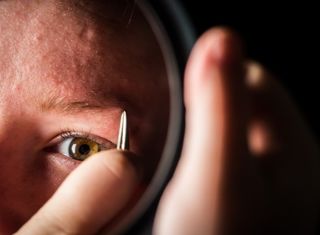
OCD
Impulsive? Compulsive? The Nature of BFRBs
How understanding the focus of repetitive behaviors affects the treatment.
Posted August 1, 2018 Reviewed by Kaja Perina
This guest post was written by Suzanne Mouton-Odum, Ph.D.
The classification of body-focused repetitive behaviors (BFRBs) has been somewhat of a conundrum since trichotillomania was first introduced into the psychiatry nomenclature. What exactly are BFRBs and how should we understand them? Are they OCD? Are they anxiety? Are they a bad habit? And, more important, how does understanding the nature of these behaviors affect how we approach treatment? In the Diagnostic and Statistical Manual for Mental Disorders IV (DSM-IV), trichotillomania was listed as an Impulse Control Disorder along with pyromania, compulsive gambling, kleptomania, and a few others. Skin Picking was not even mentioned in this manual.

Are BFRBs Impulsive?
Hair pulling, skin picking and other BFRBs can certainly have an impulsive flavor, "impulsive" being defined as being done without planning or consideration of the consequences, often because an action simply feels right in that moment. Many people describe BFRBs as occurring outside of their awareness, with an almost automatic process driving the behavior. This impulsive, in-the-moment, no-regard-for-the-consequences type of pulling seems to accurately describe some people with BFRBs at least some of the time. For many people, however, BFRBs are more complicated than simply an impulse.
Many people have thought of BFRBs as "similar to" or “a form of” Obsessive Compulsive Disorder (OCD). In the DSM-V, published in 2013, trichotillomania was moved from Impulse Control Disorders to a new category, Obsessive Compulsive and Related Disorders, and skin picking (Excoriation Disorder) was included in the manual for the first time under the same category. This change reflects the continued struggle regarding how to classify BFRBs with the conundrum being, "is it impulsive or is it compulsive?”
Are BFRBs OCD?
OCD is an anxiety disorder characterized by obsessions or thoughts that lead to anxiety. Compulsions or rituals are performed to reduce this anxiety. BFRBs have some fundamental differences from OCD. First, with BFRBs, there are no obsessions. For example, people with BFRBs typically do not have thoughts such as “If I don’t pull my hair or pick my skin," some specific bad outcome will happen, e.g., "my husband will die.” Second, while some people report a reduction in anxiety with pulling/picking, many do not. Third, people with OCD feel compelled to perform their rituals/compulsions, but generally do not like them and feel upset that they “have” to perform them. Alternately, people with BFRBs report feeling gratified and soothed by their BFRB, disliking only the outcome of their pulling and picking. Finally, the medications that typically work for OCD do not have the same positive impact on reducing BFRBs.
Despite these differences, there are some noteworthy similarities between OCD and BFRBs. First, both behaviors involve repetitive actions that cause problems for a person. Second, some people with BFRBs do indicate that they have beliefs about their hair that sound more "obsessive” or "perfectionistic” in nature. For example, some people report pulling out certain identifiable hairs that have unusual characteristics such as being coarser, thicker, curlier, darker, or lighter than other hairs or that they need the eyebrows to match or all lashes to line up perfectly. People with skin picking disorder will report picking in response to a skin aberration such as a blemish or ingrown hair or maintaining beliefs that excoriate must be removed from the skin for the skin to heal properly. These thoughts resemble obsessions in that they are tightly held beliefs that lead to behaviors which satisfy the belief, even if the behaviors cause problems. One could argue that for some people, BFRBs have more of an OCD flavor to them.
Focused vs. Automatic
Researchers have tried to categorize people with BFRBs in terms of the focus of the action, either automatic (behavior which is largely out of a person’s consciousness and feels more impulsive or habitual) or focused (behavior which is more goal directed and occurs as the focus on a person’s attention and feels more compulsive). In a way this delineation seems to mirror the impulsive vs. compulsive nature of the behavior. The goal of such categorizations is to drive treatment, i.e., if one is a more compulsive or focused puller/picker, you would treat that person with interventions that address thoughts, beliefs, and emotional aspects if they are present, e.g., anxiety. Conversely, if one is a more impulsive or automatic puller/picker, interventions would address environmental cues, awareness enhancing techniques, and impulse control strategies. The main difficulty with this approach seems to be that most people do not fit neatly into one category or the other. Many people with BFRBs report that sometimes they are aware of their behavior and it is the focus on their attention, while at other times they engage in pulling or picking in a more automatic, conditioned fashion.
Treatment Considerations
How does all of this affect treatment?
Treatment must be mindful of these differences and not make assumptions about what is driving the behavior for any individual. Mental health professionals must approach each individual as unique; seek to understand the functional nature of BFRBs for each client; and prescribe interventions that are personalized for that individual. Using a comprehensive approach to treatment, therapy is able to uncover internal and external cues for hair pulling and skin picking and select interventions that accurately correspond. This approach allows for the introduction of interventions that satisfy both the impulsive and/or compulsive nature of BFRBs for each individual.

Suzanne Mouton-Odum, Ph.D., is the Director of Psychology Houston, PC, The Center for Cognitive Behavioral Treatment. She is a Clinical Assistant Professor at Baylor College of Medicine and President of PsycTech, Ltd., Technology for Psychology. She has practiced psychology for over 20 years in the Houston area and has extensive experience conducting cognitive behavioral treatment for children, adolescents, and adults, psychological assessment, and evidence-based psychological treatments. Dr. Mouton-Odum is a member of the Scientific Advisory Board of The TLC Foundation for Body Focused Repetitive Behaviors, formerly the Trichotillomania Learning Center, and past president of both the Texas Psychological Foundation and the Houston Psychological Association. She has published numerous journal articles and is coauthor of three books for the general public: A Parent Guide to Hair Pulling Disorder, Out of the Rabbit Hole: A Road Map to Freedom from OCD, and Psychological Interventions for Children with Sensory Dysregulation.

